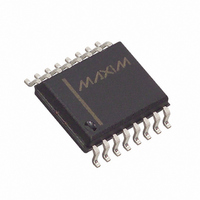MAX195BCWE+ Maxim Integrated Products, MAX195BCWE+ Datasheet - Page 24

MAX195BCWE+
Manufacturer Part Number
MAX195BCWE+
Description
IC ADC 16BIT 85KSPS SHTDN 16SOIC
Manufacturer
Maxim Integrated Products
Datasheet
1.MAX195BEWE.pdf
(28 pages)
Specifications of MAX195BCWE+
Number Of Bits
16
Sampling Rate (per Second)
85k
Data Interface
QSPI™, Serial, SPI™
Number Of Converters
2
Power Dissipation (max)
80mW
Voltage Supply Source
Analog and Digital, Dual ±
Operating Temperature
0°C ~ 70°C
Mounting Type
Surface Mount
Package / Case
16-SOIC (0.300", 7.50mm Width)
Lead Free Status / RoHS Status
Lead free / RoHS Compliant
Figure 27. Histogram of 16,384 Conversions Shows Effects of
Noise and Averaging
If a pure sine wave is input to an ADC, AC integral non-
linearity (INL) of an ADC’s transfer function results in
harmonics of the input frequency being present in the
sampled output data.
Total Harmonic Distortion (THD) is the ratio of the RMS
sum of all the harmonics (in the frequency band above
DC and below one-half the sample rate, but not includ-
ing the DC component) to the RMS amplitude of the
fundamental frequency.
16-Bit, 85ksps ADC with 10µA Shutdown
24
Figure 26. Effective Bits vs. Input Frequency
______________________________________________________________________________________
18
16
14
12
10
8
6
4
2
0
16
15
14
13
12
11
10
0.1
8021
f
T
S
NO AVERAGING
A
= 85kHz
= +25°C
CONVERSION
OUTPUT CODE (HEXADECIMAL)
8022 8023
IDEAL
Total Harmonic Distortion
FREQUENCY (kHz)
1
8024
8025
RUNNING
AVERAGE OF
5 SAMPLES
V
V
UNIPOLAR MODE
85ksps
10
REF
AIN
= +2.25V
= +4.5V
8026
8027
100
through V
Characteristics includes the 2nd through 5th harmon-
Spurious-free dynamic range is the ratio of the funda-
mental RMS amplitude to the amplitude of the next
largest spectral component (in the frequency band
above DC and below one-half the sample rate).
Usually, this peak occurs at some harmonic of the input
frequency. However, if the ADC is exceptionally linear,
it may occur only at a random peak in the ADC’s noise
floor.
Figures 29 and 30 show the MAX195’s transfer func-
tions. In unipolar mode, the output data is in binary for-
mat and in bipolar mode it is offset binary.
This is expressed as follows:
where V
harmonics. The THD specification in the Electrical
ics. In the MAX195, this distortion is caused primarily
by the changes in on-resistance of the AIN sampling
switches with changing input voltage. These resis-
tance changes, together with the DAC’s capacitance
(which can also vary with input voltage), cause a
varying time delay for AC signals, which causes sig-
nificant distortion at moderately high frequencies
(Figure 28).
Figure 28. Signal-to-Noise + Distortion vs. Frequency
THD = 20log
1
100
N
is the fundamental RMS amplitude, and V
95
90
80
75
70
85
65
60
are the amplitudes of the 2nd through Nth
0.1
f
T
S
A
Spurious-Free Dynamic Range
= 85kHz
= +25°C
V2 + V3 + V4
2
FREQUENCY (kHz)
1
2
Transfer Function
V1
10
2
+ ...+ V
100
N
2
2









